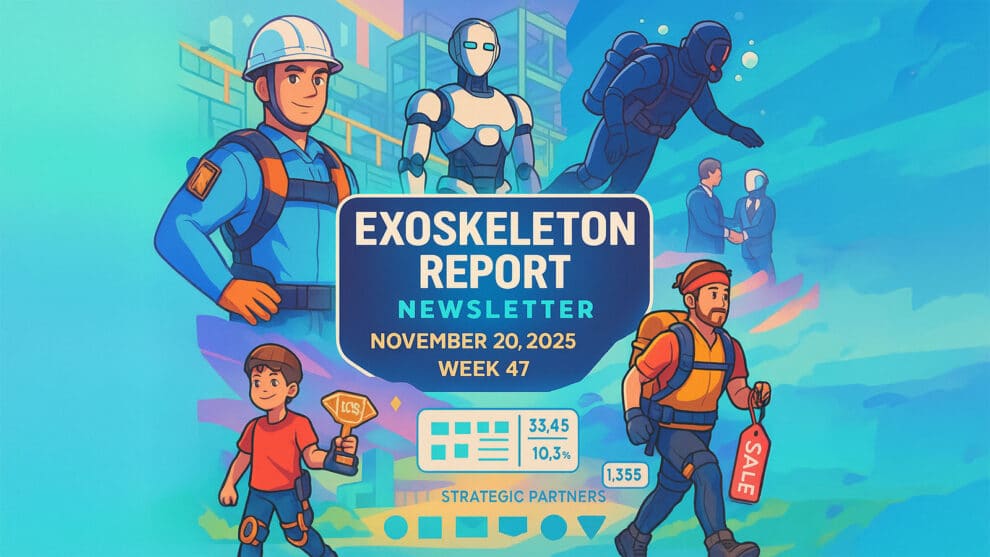It has been another week in the exoskeleton industry on its slow march to becoming mainstream. I believe that this technology can positively impact the lives of millions, but first, it needs to become mainstream. Each week is a step forward in that direction, and it needs to be acknowledged and celebrated!
Text Version:
- Updated the event calendar with 8 newly listed exoskeleton-focused events for 2026, expect more to come soon, like the ACE Challenge and Exo Games
-
3 Keys to Mainstreaming Exoskeletons in the Next Five Years
Did you miss WearRAcon Europe 2025 or didn’t catch the closing presentation!? The HeroWear team has you covered! Mark Harris, HeroWear co-founder and CEO, lays out steps for the exoskeleton industry to help speed adoption and mainstream exo technology.
-
Wandercraft and SAPA Announce Deployment Partnership in Industrial Manufacturing, Cementing Europe’s Emerging Championship in the Humanoids Race
SAPA becomes Italy’s first industrial manufacturer to formally commit to humanoid robots in its automation roadmap.
-
Comau’s MATE-XB exoskeleton gains EU Category II PPE certification
MATE-XB has been certified as Category II Personal Protective Equipment (PPE)under EU Regulation 2016/425. That means it meets defined European standards for worker protection and ergonomics, not just comfort. With this status, companies can now treat the exoskeleton like other PPE in their risk assessments, safety procedures, and documentation. This makes the MATE-XB easier to justify purchasing as a preventive safety measure.
- Key Takeaways from the A+A Trade Fair 2025 — What Will Shape the Future of Workplace Safety, by WearHealth
- German Bionic Systems GmbH, a leading AI-powered industrial exoskeleton maker, has filed for insolvency after a promised funding round collapsed and is now preparing a formal M&A process to secure a strategic investor by Q1 2026. If you’re an industrial, robotics, or private equity investor looking for exposure to wearable robotics, this is a rare opportunity to acquire a patent-rich, globally deployed exoskeleton platform (EXIA, etc.) while operations and customer support continue under court-supervised restructuring.
-
UnitedHealthcare Medicare Advantage Plan Issues Prior Authorization Approval for a ReWalk 7 Personal Exoskeleton
Lifeward Ltd. announced that a UnitedHealthcare Medicare Advantage Plan has issued its first prior authorization approval for a ReWalk 7 Personal Exoskeleton, a major step in making this technology more accessible to people with spinal cord injury. The decision means UnitedHealthcare will cover the device for an eligible member, signaling growing payer adoption of personal exoskeletons following the 2024 CMS decision that created a formal reimbursement pathway for these devices. Lifeward frames this as important not only for expanding coverage and predictable reimbursement in the U.S. market, but also for improving mobility, independence, and quality of life for individuals with disabilities.
|
- CYBERDYNE’s financial report for the period April 1, 2025 to September 30, 2025 shows an 8.4% year-on-year decrease in overall revenue, mainly due to lower service income (both over-time and point-in-time), partially offset by higher product and asset sales.
|
“WIRobotics’ wearable walking-assist robot, “WIM KIDS,” has been honored with the CES 2026 Innovation Award in Digital Health, marking three consecutive years of CES Innovation Award recognition since 2024. With its ultra-light 990g design and growth-adaptive frame that supports children from ages 4 to 15 with a single device, WIM KIDS builds confidence in walking and motivates children to move on their own — a true companion in growth through technology.”
- Innovative underwater exoskeleton boosts diving efficiency
A team led by Prof. Wang Qining at Peking University has developed a bilateral, cable-driven knee exoskeleton for divers that provides targeted assistance during the flutter kick. In tests with six experienced divers, using the powered exoskeleton compared to normal diving reduced air consumption by 22.7%, while quadriceps and calf muscle activation dropped by 20.9% and 20.6%, respectively. The divers also adapted well to the device and were able to maintain natural kicking patterns, indicating that the system improves efficiency without disrupting normal movement.
Make sure to subscribe to the newsletter rather than waiting for the archive version to be posted.










Add Comment